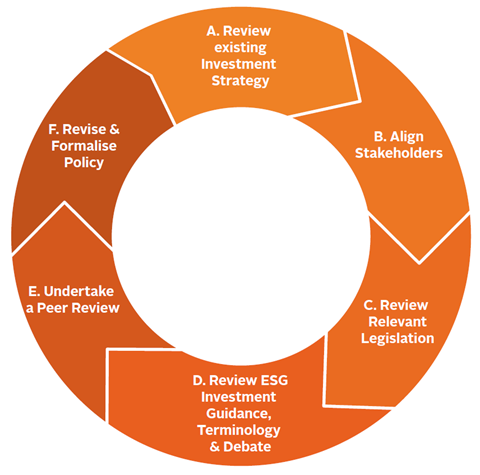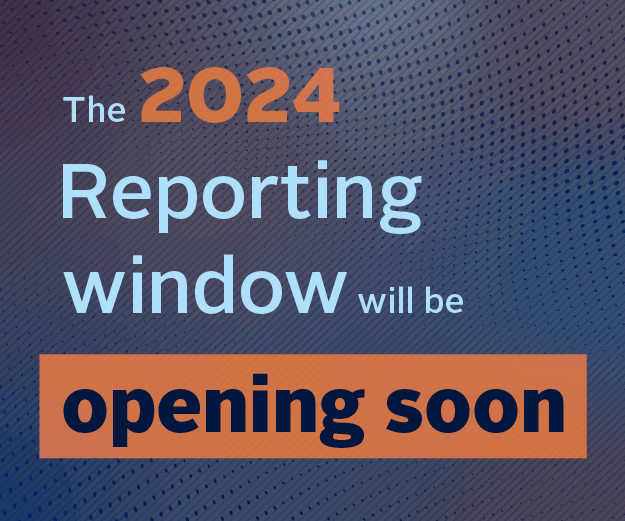Investment policy is instrumental to achieving an organisation’s vision and mission.
For it to be effective, it needs to be aligned with investment strategy (a high-level strategic plan for achieving your investment objectives).

An investment policy should:
- outline your investment objectives;
- give specific guidance to investment processes;
- give specific guidance on your standards for measuring success/performance.
Staying within ESG, a policy revision can highlight the predominant ESG issues influencing your investments / portfolios at large, the appropriateness of skillsets and capacity of actors involved in carrying out the policy, and overall direction where work can be done to improve.
The following process provides steps to be considered during your investment policy revision and development process. It assumes that your organisation has already reviewed its investment strategy and all material long-term factors (including ESG) within it. Investment strategy will form the highest order guidance for the revision of your policy and therefore the construction of your investment portfolios. However, if your organisation has yet to consider and incorporate ESG factors at the strategic level, an increased awareness of critical factors in your current policy can be a sufficient temporary solution.
A. Review existing investment strategy
Before undertaking policy revision, review your organisation’s strategy to make sure any resulting policy development is aligned with organisational purpose and beneficiary interests.
If your organisation hasn’t yet developed an investment strategy, the policy revision process can still be an important step in identifying how your organisation will seek to address ESG factors, as well as trigger the organisational review of key strategy inputs.
Action points
Organise a board/investment committee discussion to kick off the your strategy revision work, which will address the following issues.
- Does your organisation have a comprehensive investment strategy which accounts for long-term trends? PRI fs Crafting an Investment Strategy guidance on investment strategy development highlights key aspects to consider.
- How does your organisation view ESG factors? Are you conducting this review for risk-management purposes, to unlock new opportunities, or a combination of both?
- What is your rationale for updating your policy? And why now? Is it a best practice requirement?
- What considerations must your policy include to meet your organisation’s investment strategy and objectives?
Publish your investment strategy and/or principles. If your organisation has yet to undergo a formalised investment strategy review process which considers long-term trends, at a minimum, issue a statement committing to responsible investment practices and describe your organisational approaches to them.
If internal resources are limited, contact the PRI or consider working with an external advisor/investment consultant to help you develop your strategy process and investment principles, to open the door to new considerations which may not be immediately obvious to internal investment committees, executives, and/or board members.
B. Align stakeholders
To start, engage executives so there is sufficient support in the organisation (including the board) to execute the policy revision process. Involvement, or at least support, of the organisation’s highest governing bodies is critical for your policy to be effectively developed, applied and implemented. The policy’s cultural fit to your organisation and formal governance structure ‘buy-in’ is also a crucial ingredient for an effective policy.
Before any revision occurs, your institution must be clear on who holds ownership of the policy and who will administer it. With these cornerstones in place, writing is made easy and collaborative, with input from mainstream investment and responsible investment/ESG experts, as well as management, board members, and potentially other stakeholders.
Action points
Conduct an organisational SWOT analysis or assessment exercise: where are you currently, what are your organisation fs ambitions in terms of future investment practices? Areas to consider include:
- current investment policies and processes regarding both investment and ownership decisions;
- governance structure and management systems;
- resources and skillsets;
- performance and reporting metrics.
Establish and clearly define responsibilities in the organisation for the policy revision process. For example:
- board of trustees: validation of investment strategy; approval and sign-off of policy;
- investment committee: oversight of investment policy development and review;
- Chief Investment Officer: development and formulation of investment policy;
- project teams: policy revision process and project management;
- ESG specialist: responsible for ESG-relevant input.
Create a stakeholder matrix in which key stages of policy revision/development are identified and the roles and responsibilities of all relevant internal and external stakeholders are plotted.
If possible, set deadlines for key stages such as the next board meeting or your PRI reporting cycle, etc. This will hold key policy stakeholders accountable and prevent key staff from getting lost in the project process.
C. Review relevant legislation
This guide focuses on the incorporation of ESG into investment policies, as their separation does not allow for a holistic consideration of long-term factors. Relevant ESG regulation and public policy frameworks should not be a blind spot, but rather provide the backbone for your policy. Asset-owner-specific regulations and wider public policy framework regarding issues (such as fiduciary duty, ESG transparency and reporting requirements, environmental regulations, pension fund regulations) should not be overlooked. Additionally, national stewardship codes and corporate governance codes such as the G20/OECD’s Principles of Corporate Governance can bring to light further policy considerations.
To start, refer to the PRI’s Regulation map, which is an interactive database of policy initiatives from across the globe that support or encourage responsible investment.
Action points
Discuss relevant ESG legislation at board/trustee meeting. At a board meeting, consider holding a discussion with board members, the project team, and the compliance team on the ESG frameworks your organisation must adhere to, so everyone is aware of relevant legislation.
Establish a process for tracking and monitoring legislative developments. Review and define organisational capacity for following ongoing regulatory developments to make sure all stakeholders are up to date on relevant framework.
D. Review ESG investment guidance, terminology and debate
Getting familiar with investment trends that incorporate ESG considerations is crucial because a broad spectrum of reference materials and intellectual capital will help you to create a best in class policy.
All investment and policy review stakeholders, from board members responsible for policy approval to investment staff responsible for the day-to-day management/allocation of funds, should familiarise themselves with factors able to influence policy (including ESG) and their possible effect on the ability of your assets to deliver expected financial and real economy influence outputs.
To start, look through the PLSA (formerly NAPF) document ESG made simple guide or PRI’s How asset owners can drive responsible investment. Additionally, asset owner specific literature, including the PLSA’s Responsible Investment guidance for pension funds, the EUROSIF’s Corporate Pension Fund Sustainable Investment Study, EUROSIF’s PRIME Toolkit and USSIF’s Unleashing the Potential of US Foundation Endowments, will also prove to be helpful.
Once relevant ESG areas have been understood and covered, take your understanding a step further by considering asset class specific issues using advanced guidance from the PRI (found here). Furthermore, educational institutions (like the CFA Institute or PRI Academy), ESG data, and research providers can offer insight into trends you may want to consider.
Action points
- Review existing literature. In addition to resources mentioned above, take a look through additional resources in appendix B for guidance on general ESG topics.
- Contact the PRI, access resources on the PRI website, or enrol in courses offered by the PRI Academy for additional insight and guidance on ESG issues within specific asset classes, responsible investment best practice, and stewardship activities.
- Consider contacting your local responsible investment organisation some of which are found in appendix A, for additional guidance pertaining to your local market.
- Conduct a materiality analysis: identify, define, and assess key ESG factors for your organisation and stakeholders (KPMG’s Sustainable Insight: The Essentials of Materiality Assessment may be useful here).
E. Undertake a peer review
Understanding what your peers are doing will spur high level investment policy discussions and even help the drafting of the policy itself. Some responsible investment practices may not be addressed with the same structure and rigor as more traditional items of an investment policy statement; others may feature holistically in investment policy structure and broader practice. Consider the pros and cons of the approaches you encounter.
- How does your investment policy structure compare to your peers?
- How are stakeholders involved into the policy revision approach?
- How are ESG risks or opportunities defined and identified?
- How are ESG issues weighed and valued in investment decisions?
- What, if anything, has the organisation done to effect positive real-world influence through their portfolio?
Peer reviews shine light on how investment policies were formulated and the outcomes they produced. Going further than a ‘policy format’ only review shows how different approaches/strategies deliver value to different organisations.
Action points
Consult policy examples from PRI signatories in appendix C, as well as the Strategy & Governance module of the PRI Transparency Reports for insight on what others are doing to incorporate ESG considerations.
Contact your local responsible investment organisation to identify more peers with policies that address ESG and long-term investment considerations.
Conduct a peer analysis consisting of:
- Which stakeholders were involved with policy development? How were they involved and at what stages?
- How were ESG risks or opportunities defined and identified, and how are they weighed and valued in investment decisions?
- How were specific processes and practices used to reflect ESG factors within investment processes?
- How are outcomes and results monitored, reported, and disclosed?
Download the full report
Investment policy: process and practice
- 1
- 2
Currently reading
Getting started on an integrated investment policy
- 3
















